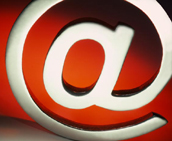@
Not to be confused with A.
@ is the little symbol that pops up when you hold down "Shift" and press the apostrophe. It has exactly one purpose: it delineates a user from a host in an e-mail address. For example, in the address "gov.sarah@yahoo.com," gov.sarah is the user, and yahoo.com is an indication that she should probably be impeached.
Technically, any key could have been used for this purpose, but the one they settled on was "@." Strangely, however, the key "@" predates e-mail and, in fact, the computer keyboard, going all the way back into the typewriter era. This makes "@" the only key on the typewriter that had no meaning whatsoever.
So, how did it get there? It's kind of a funny story.
History[edit | edit source]
Background[edit | edit source]
In 1867, Eliphalet Remington II, CEO of a sewing machine company, decided to invent a standard key setting for use in the recently-invented typewriter. Until this time, keys had been placed on the typewriter entirely at random, forcing even the best typists to hunt and peck when they were seated on a new machine.
Remington decided to name his new keyboard "QWERTY," after his sister, Qwerty Remington, and set to work writing a memo instructing his chief engineer, Scott Cornwallis, to design the keyboard.
After two weeks, Cornwallis met with Remington and reported his progress. The keys had all been laid out, and, best of all, Remington's sister's name appeared written in the upper-left corner.
However, Cornwallis had one problem.
- "I put useful symbols above the numbers," Cornwallis told Remington, "but it turns out there are really only nine useful symbols. I have no idea what to stick above 2. I mean, a question mark would have been the logical choice, but you specifically said 'No question marks.'"
- "I don't like it when they ask questions." replied Remington.
- "Right... okay." said Cornwallis. "So then I thought, you know, maybe a Greek letter? Like a delta for change, or a sigma for sum, or a mu for micro..."
- "No." said Remington. "I don't trust those Greeks, with their togas and their philosophy and their man-love. You, sir, are fired."
- "But -"
- "Fired!!" roared Remington. As Cornwallis was escorted from the building, Remington looked over his unfinished plans, considered for a moment, and then wrote a redundant lowercase a over the letter 2.
Evolution of the @[edit | edit source]
Three years later, Tom Jenkins, a high-priced consultant was given the task of examining the efficiency of the newly-designed QWERTY keyboard.
Jenkins began by putting up a large picture of the keyboard and declaring that it was "a piece of shit."
- "For one thing," Jenkins began, "the keys are in horrible places. For example, what's the most common letter in the English language?"
The engineers in attendance stared at him blankly.
- "Anybody?"
One engineer raised his hand. "It's J, obviously!"
- "No! No you idiots, it's 'E'. And look where E is. Left hand, middle finger, top row. That's ridiculous. Also, where's the fucking question mark on this thing?"
There was general murmuring.
- "Oh, and one last thing. See this 'a' here? Well, look, here's" - and with this, Jenkins circled the redundant lowercase a - "another one."
Like all high-priced consultants, Jenkins' advice was completely ignored, and even to this day, keyboards do not have question marks, although we get by using the "?" symbol, which originally was just used as a substitute for profanity.
However, Jenkins' illustrative circle somehow slipped permanently into the keyboard design notes, and for decades thereafter, a circled "a" appeared on the keyboard, despite having absolutely no meaning or use whatsoever.

